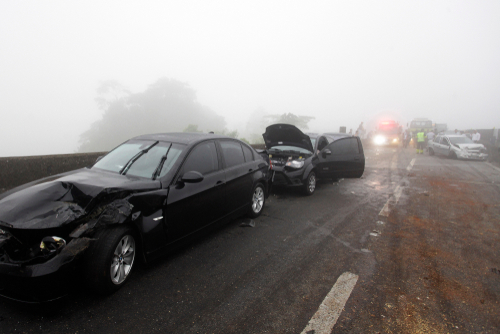Minnesota is a no-fault state when it comes to car accidents. This means drivers are entitled to certain benefits if they have been injured as the result of the maintenance or use of a motor vehicle, regardless of who was at fault for the accident.
While you may have heard about Minnesota’s no-fault system, do you understand what it means or how it may impact your recovery if you have been involved in an accident? Here, you can learn more about Minnesota car accident laws and your options for recovery if you are involved in a multi-car pileup.
What Does No-Fault Mean?
As mentioned above, because Minnesota is a no-fault state, you must first collect certain benefits from your own auto insurance policy after an accident. This is true regardless of who is considered at fault.
No-fault, also known as PIP – personal injury protection – will provide coverage for up to $20,000 for your medical costs and mileage; and up to $20,000 in wage loss and replacement services benefits. It does not, however, provide any coverage for emotional distress or pain and suffering.
If another party is at fault for causing the accident, you may have what is known as a personal injury or bodily injury claim against the at fault party and their insurance company. However, before you have the right to bring any such claim against the at fault party, you must meet one of the five statutory tort thresholds. These tort thresholds include:
- A death;
- A scar or disfigurement;
- 60 days disability;
- $4,000 in accident-related medical costs (excluding diagnostic imaging); or
- A permanent injury.
If you meet one of these thresholds and are able to bring a personal injury claim, it is possible to recover additional compensation beyond what your no-fault coverage provided. You can also recover non-economic damages like pain and suffering (among others).
Now that you know some of the rules and laws in place, it is important to learn how fault is determined in multi-car accidents.
Gathering Details About the Multi-Car Accident
In a chain-reaction or multi-car accident, many variables must be considered. This makes the legal situation more complex than other types of accident cases.
In many rear-end collisions, the driver that hits the back of another vehicle is usually considered at fault. However, with a multi-vehicle pileup, it is possible that any involved drivers may be found at least partially at fault.
When it is time to determine fault in this type of accident, the authorities (and your attorney) will look at all the details of the accident and how each impact occurred. They will try to look at each driver’s actions and how they may or may not have contributed to the crash.
An example would be if the vehicle stops on the road and results in three cars behind it slamming into one another; the following drivers could potentially be considered responsible if they were driving too fast for conditions or if they were following too closely.
If a vehicle that is stopped is hit and then pushed into a vehicle in front of it, the driver in the “middle” will probably not be at fault because they were not a contributor to the incident, and were able to safely stop in time.
Negligence and Fault
When determining fault in a multi-vehicle accident or “pileup,” the investigators will often try to find the party or parties who acted negligently. Negligence is a person’s failure to exercise proper care that a prudent or reasonable person would under the same situation or circumstances. Some common negligent actions that can cause a multi-vehicle pileup include the following:
- Driving under the influence of alcohol or drugs. Driving under the influence of drugs or alcohol is considered negligent in many cases. This is true even in situations where a doctor has prescribed the substance. Alcohol and drugs are common contributors to multi-vehicle pileups.
- Distracted driving. Many actions can be qualified as distracted driving, including talking to someone in the vehicle, putting on makeup, grooming, eating, texting, and more. Anything that takes your attention off driving can be considered a distraction.
- Disobeying posted traffic laws. If you speed or run a red light, you are not obeying the traffic laws, which may result in a multi-car accident.
- Reckless driving. Cases of reckless driving include any maneuver a driver makes that may be reckless based on the road or traffic conditions. For example, going above the set speed limit on icy roads is often considered reckless due to the conditions.
Determining and showing negligence is important in determining who is at fault for a multi-car pileup. In many cases, if many vehicles are involved, it can be difficult to determine which parties were negligent in their actions.
Additional Factors That Increase the Possibility of a Multi-Car Pileup
Other factors can increase the likelihood of a multi-care pileup, too. These include the following:
- Where the accident occurs. Multi-vehicle accidents in urban areas often happen near stop signs or lights during heavy traffic times. On highways or interstates, these types of accidents are usually caused by distracted driving, reckless driving, or speeding, especially during heavy traffic.
- Bad weather conditions. Icy conditions or heavy rain can make the roads slick, increasing your stopping distance. Very sunny conditions, fog, and heavy rains and snow, and blowing snow can also result in reduced visibility and increase the possibility of a multi-vehicle accident.
The Possibility of Shared Fault in Multi-Car Vehicle Accidents
In some situations, multi-vehicle pile ups result from several drivers’ negligence or recklessness. If this occurs, it is up to insurance companies and attorneys to determine (and often fight about) how much each party is at fault for the incident.
In some situations, one driver may be considered 100% at fault for the crash. In others, two drivers may have the fault divided among them, for example one could be considered 70% at fault, while another is just 30% at fault. In other cases, everyone involved in the accident may have some fault.
There are three ways to determine who is at fault for a multi-vehicle crash: comparative negligence, modified comparative negligence, and pure contributory negligence.
Minnesota follows the modified comparative negligence doctrine. To recover damages, a driver must be less than 50% at fault for the accident. No recovery is possible for anyone over 50% responsible for the incident.
Contact Our Legal Team for Help with Your Accident Claim
If you are involved in a multi-car pileup, you may wonder what to do and where to turn. In these situations, our legal team at Nelson Personal Injury, LLC is ready to help.
We have years of experience helping accident victims and ensuring they recover the compensation they are entitled to. We can provide the same quality representation and help you understand your rights.
Read More






